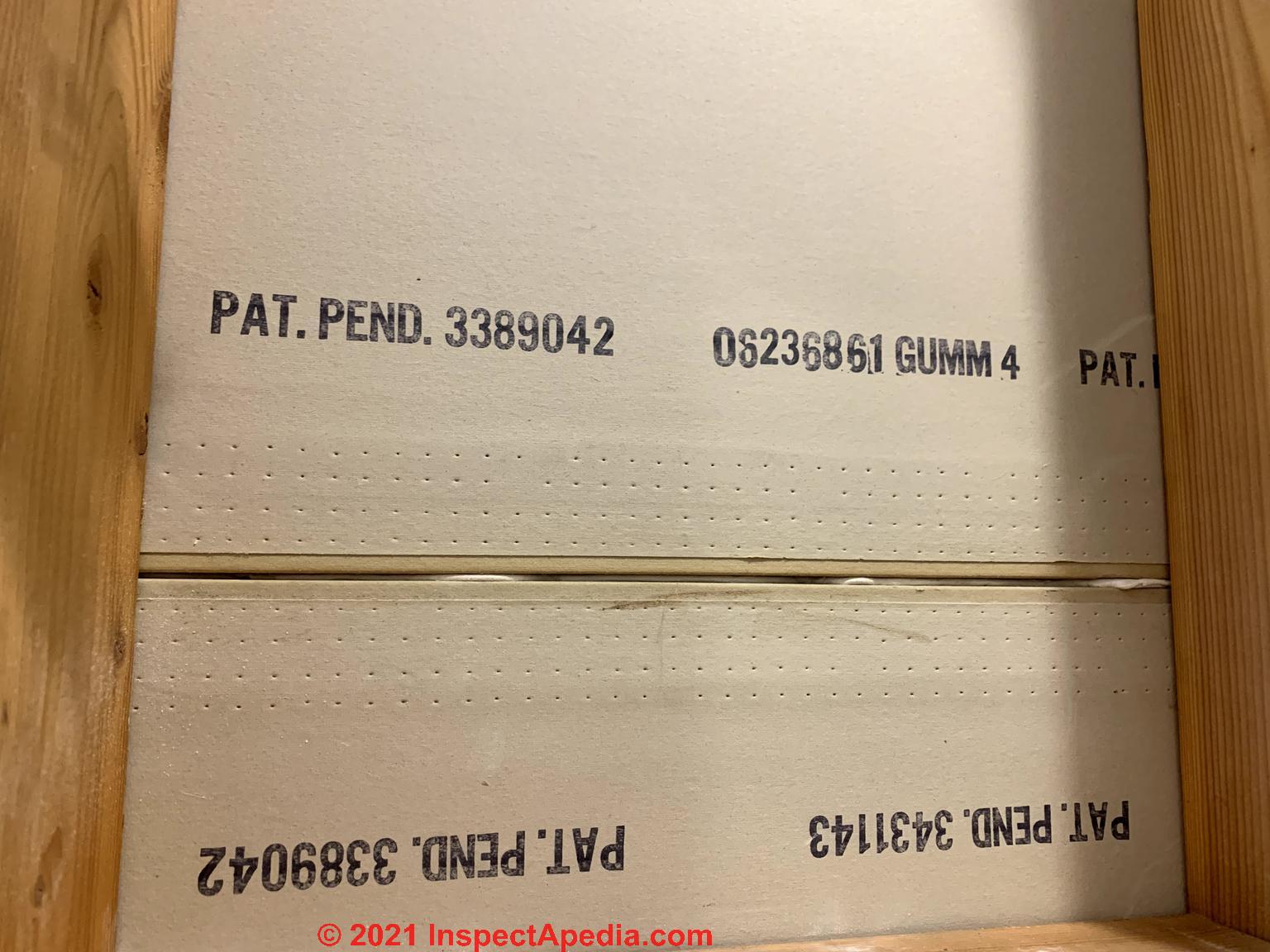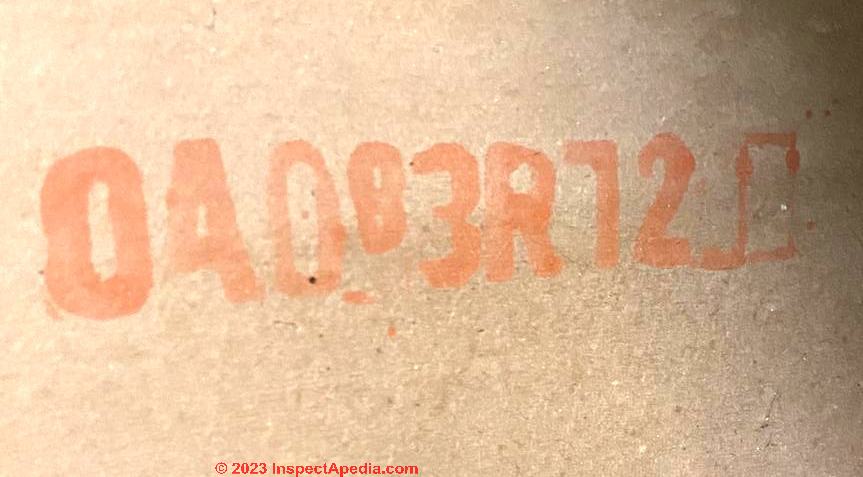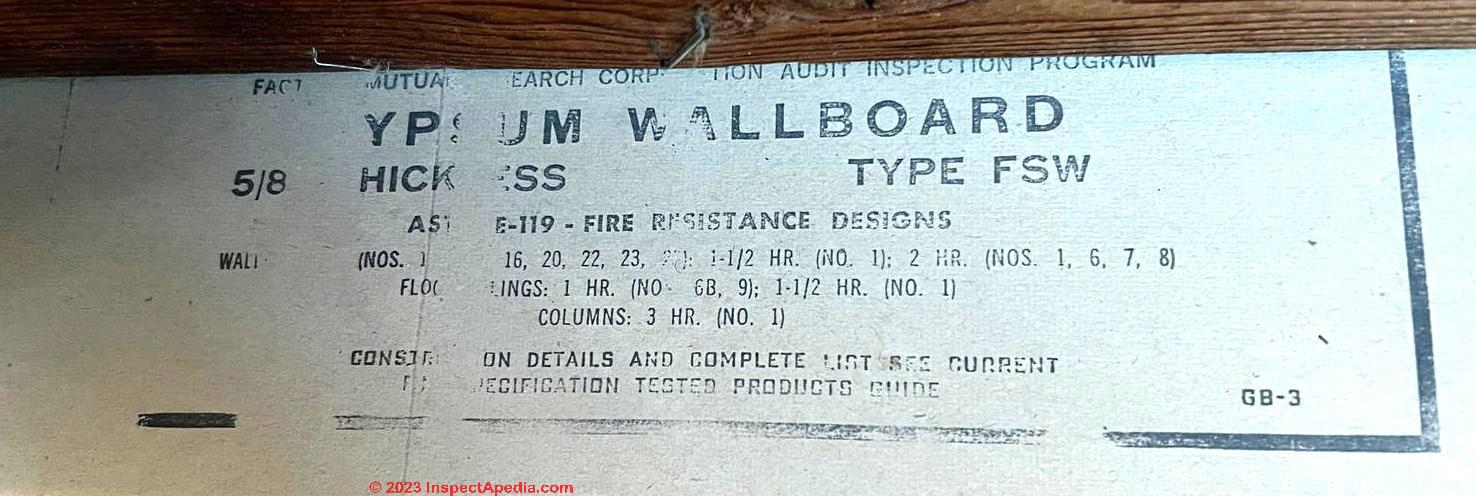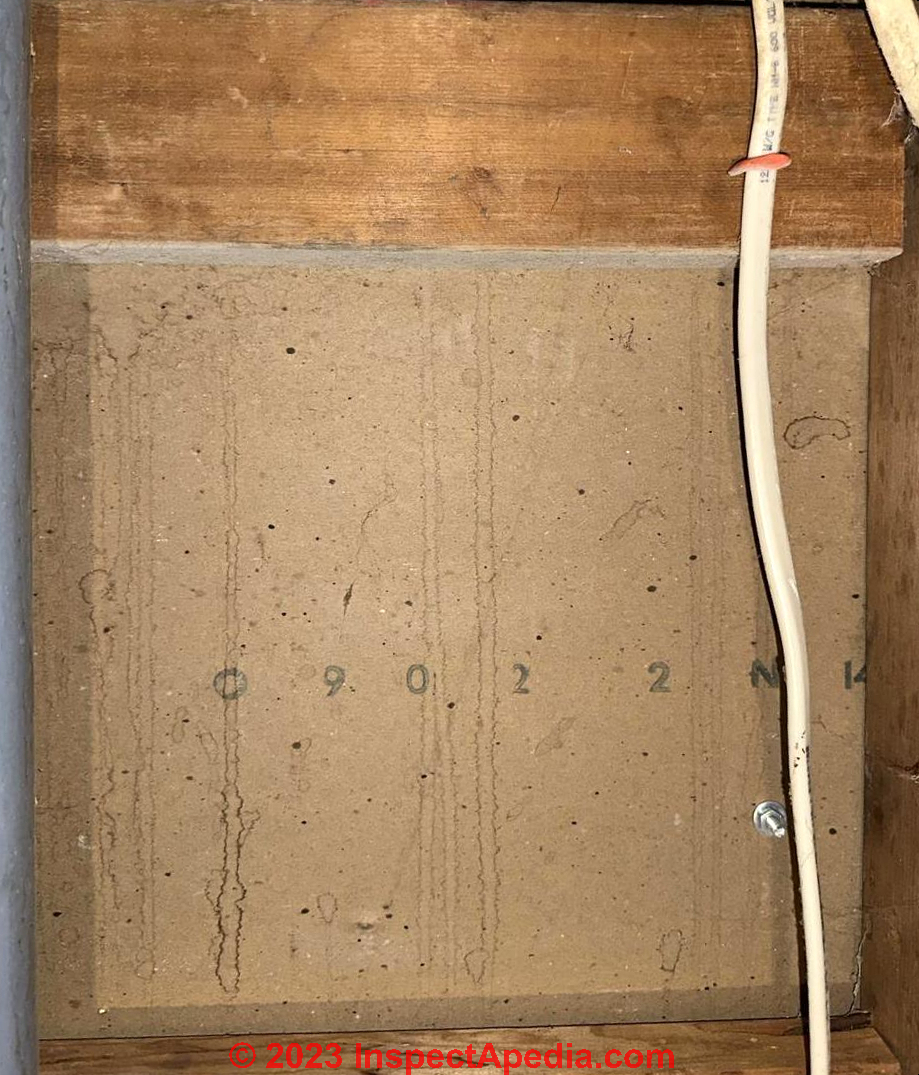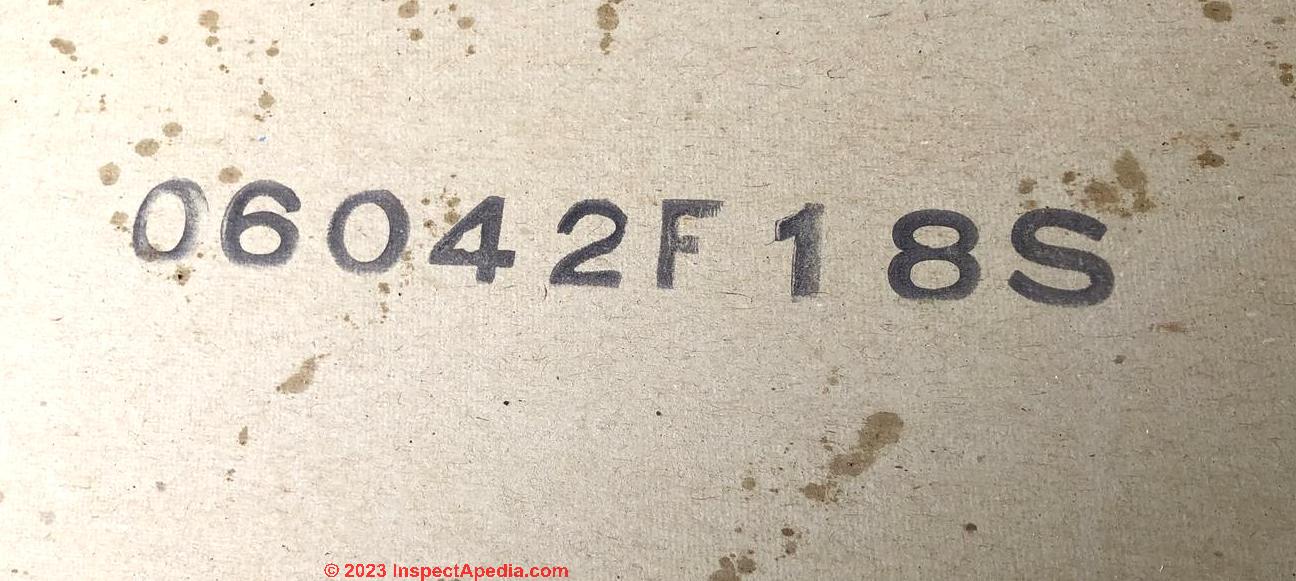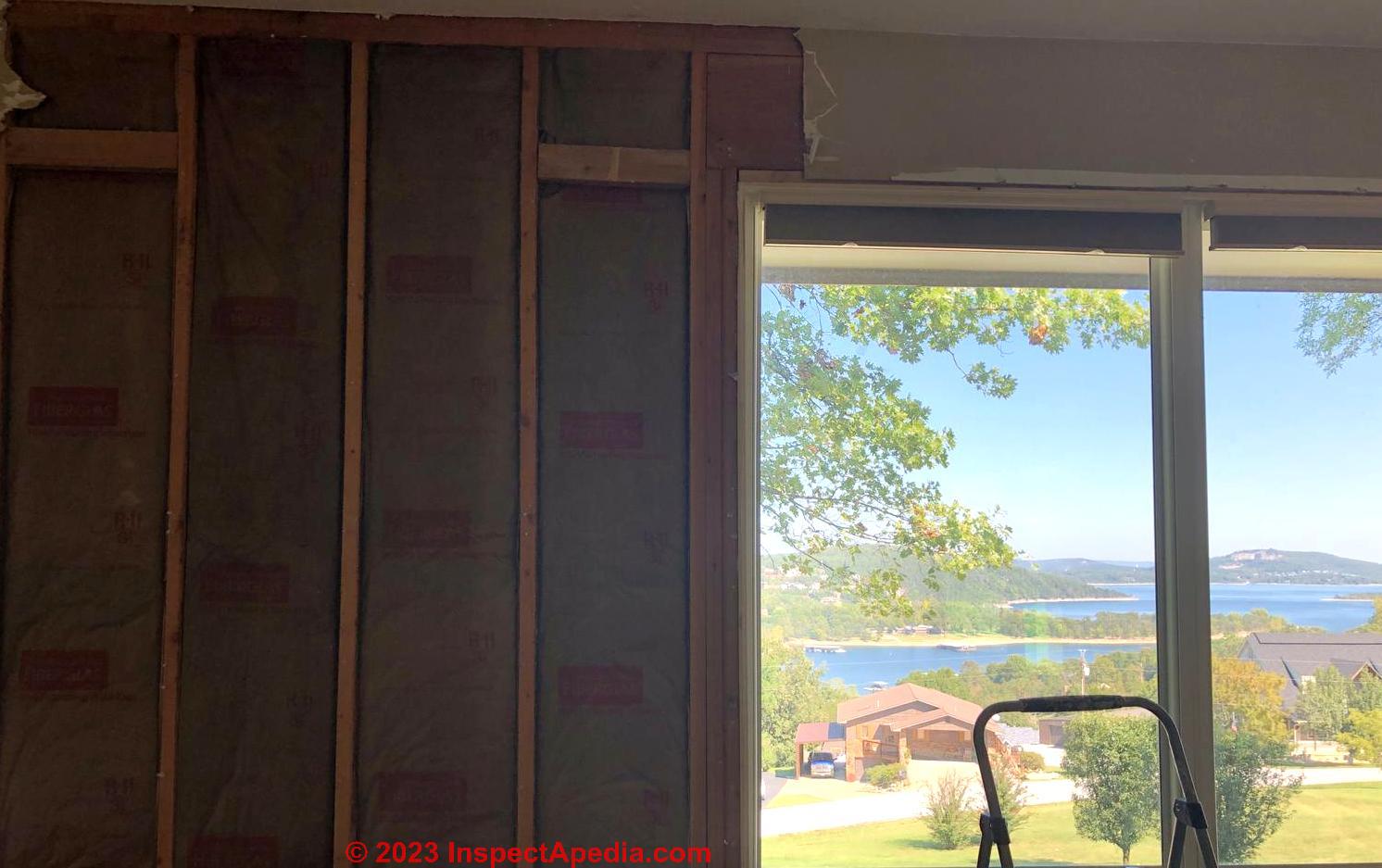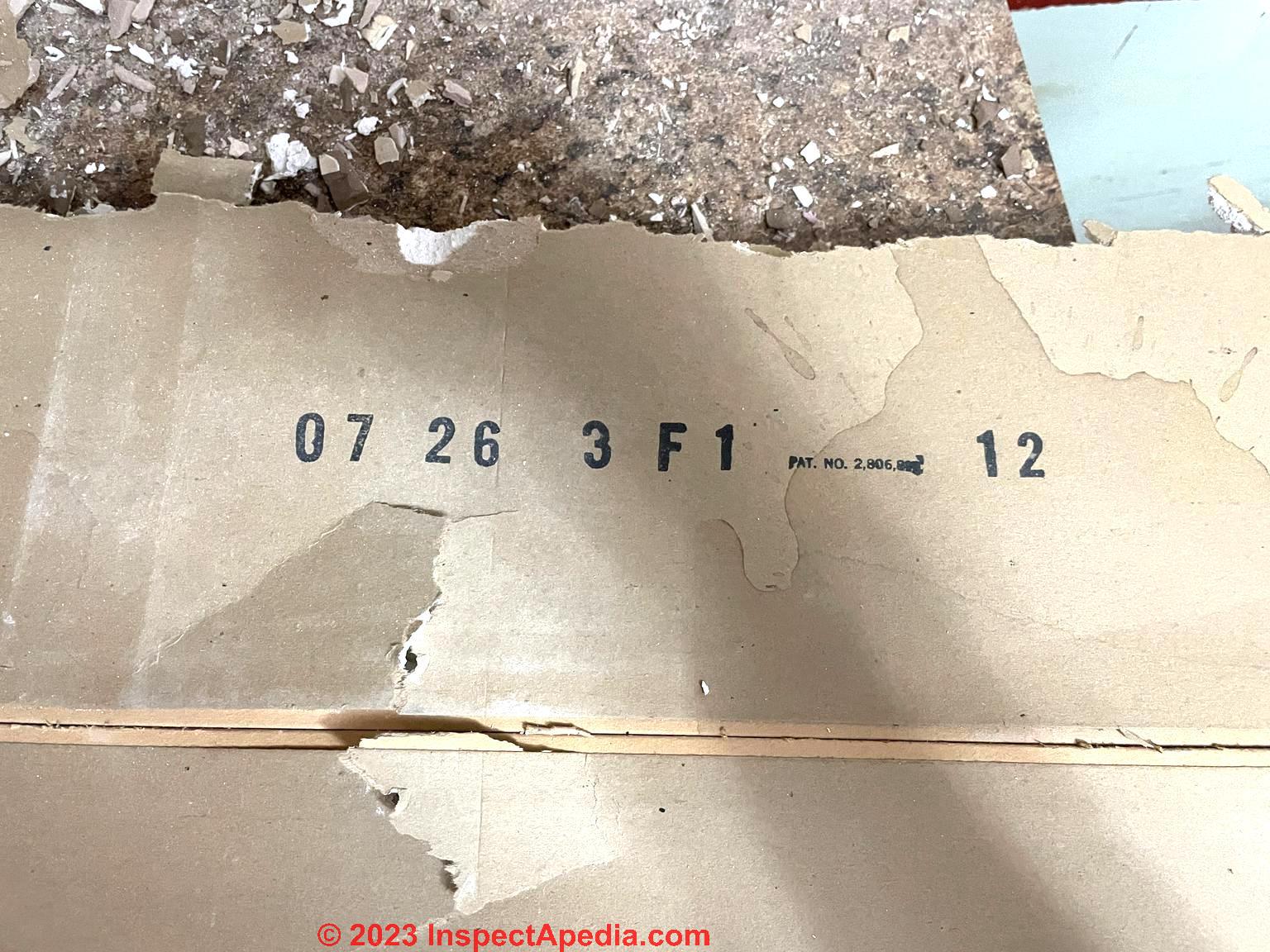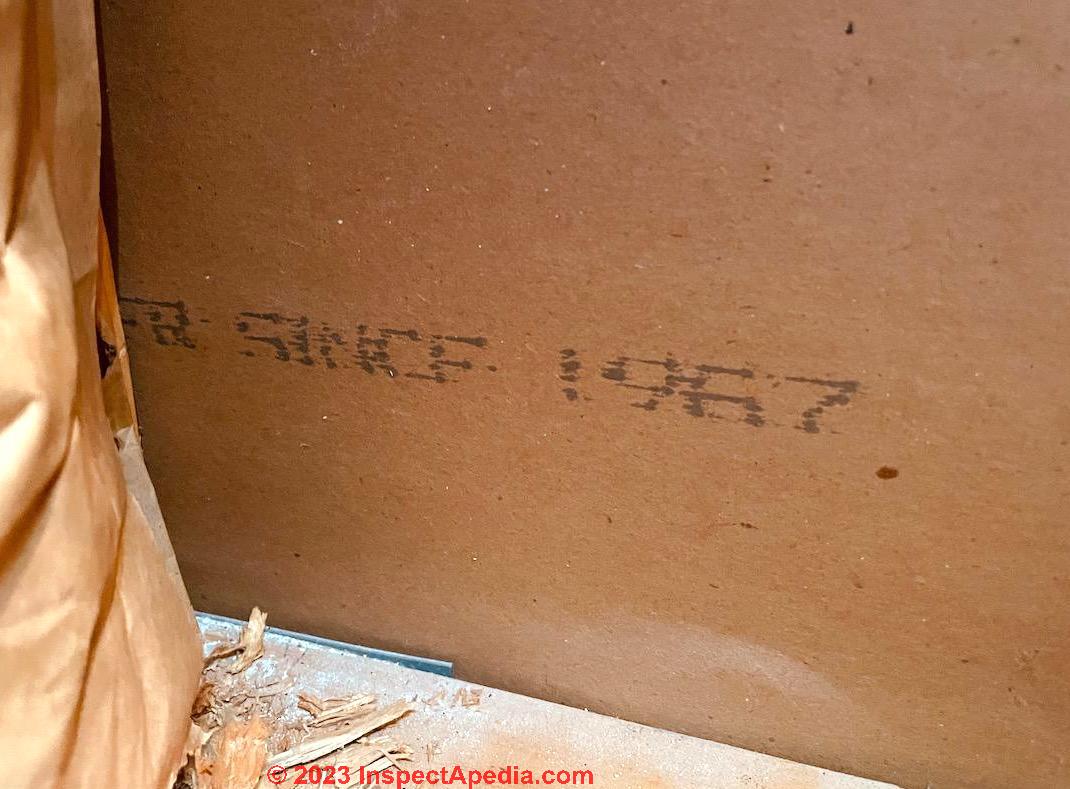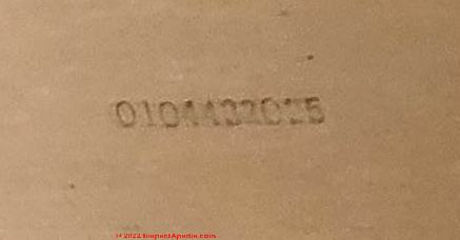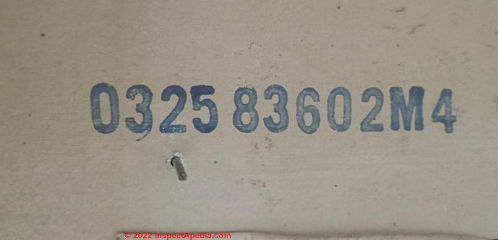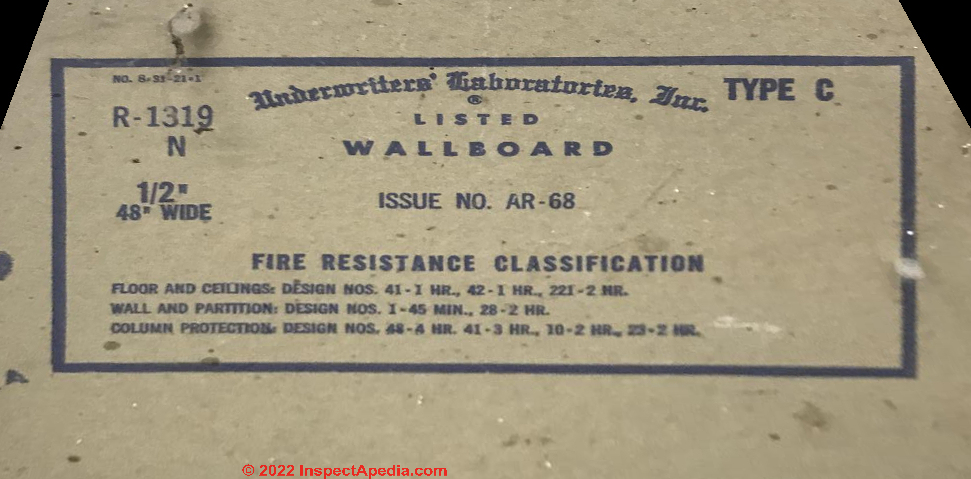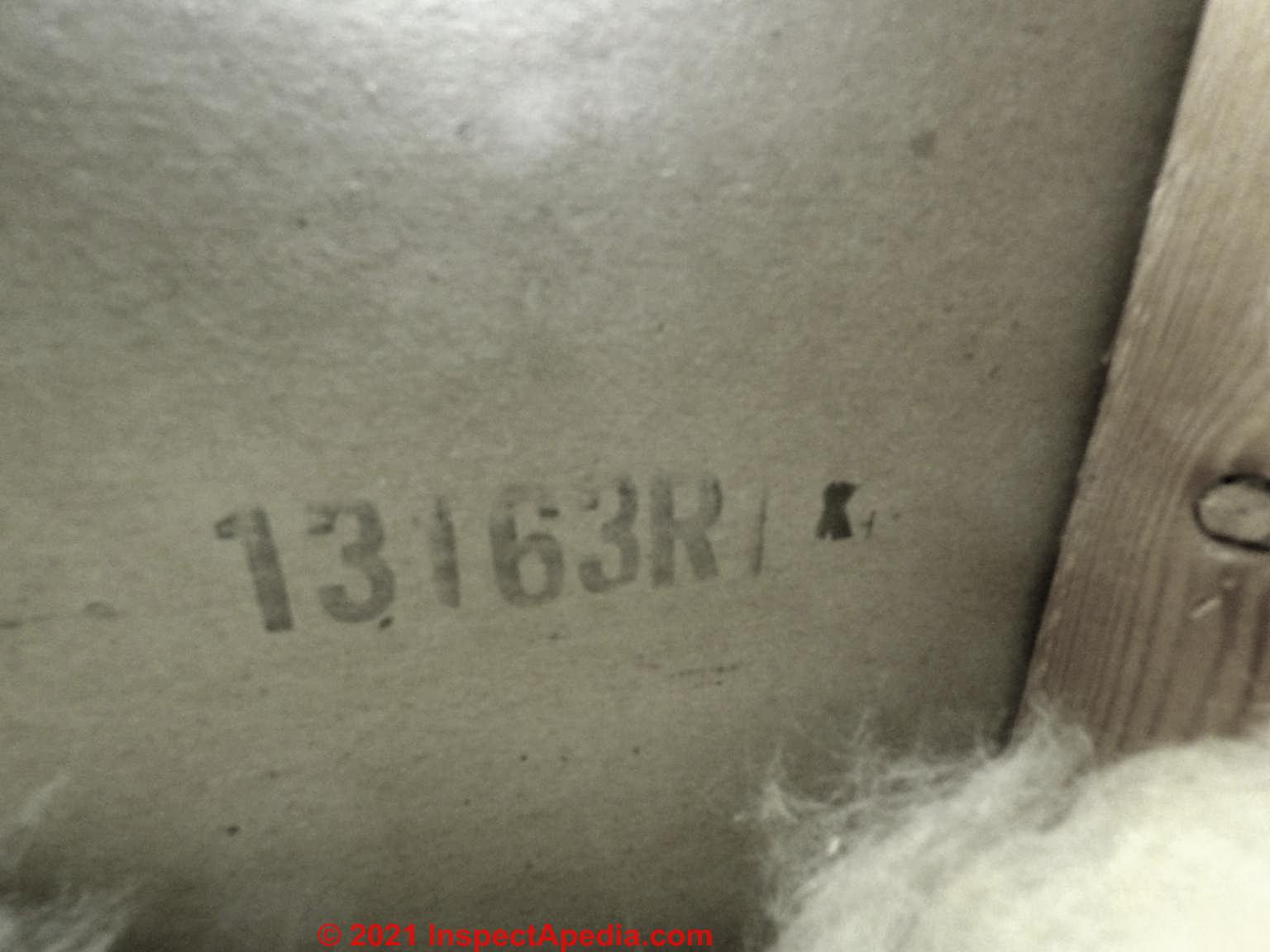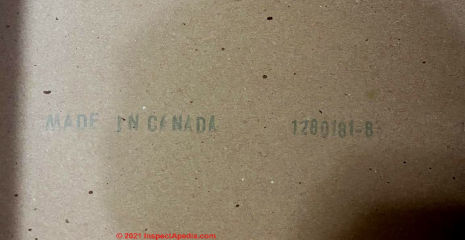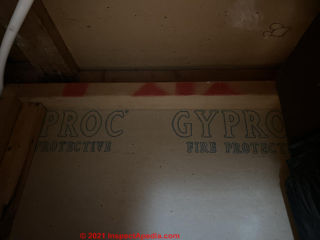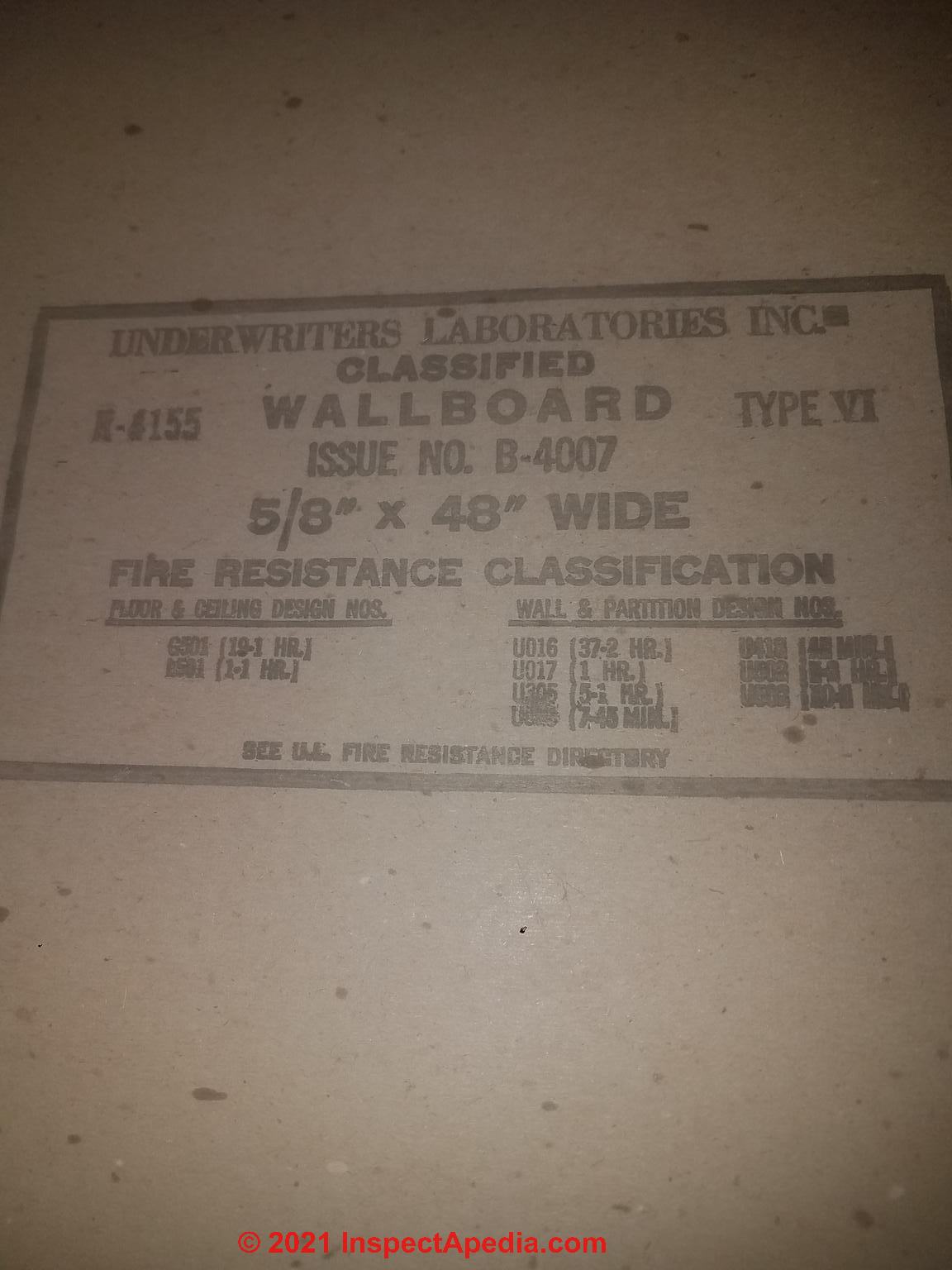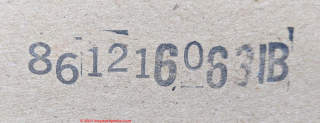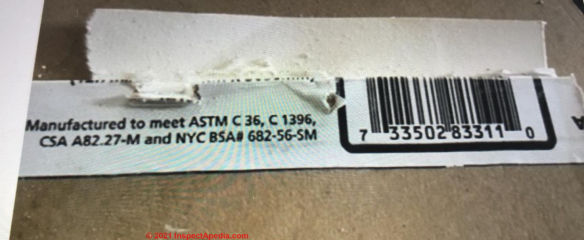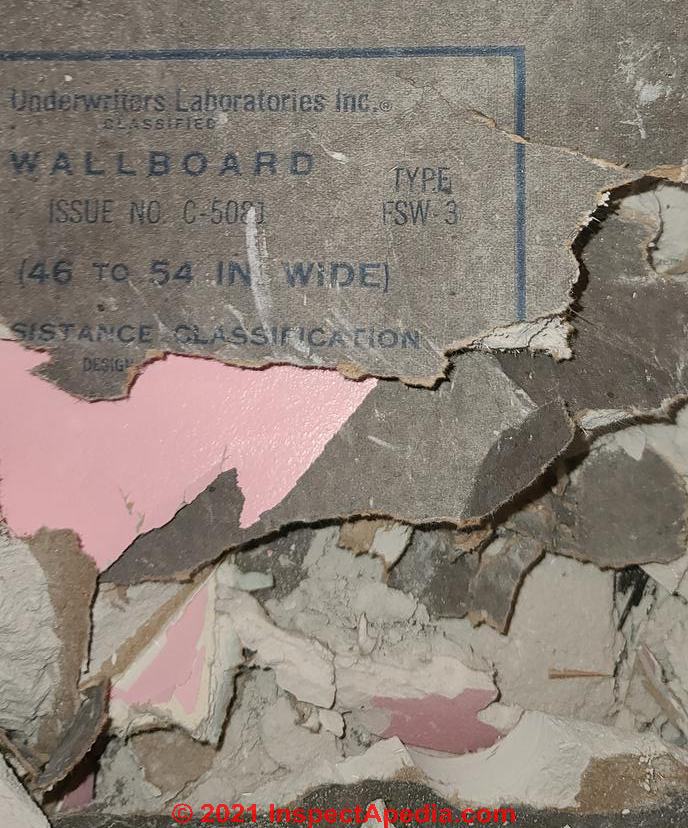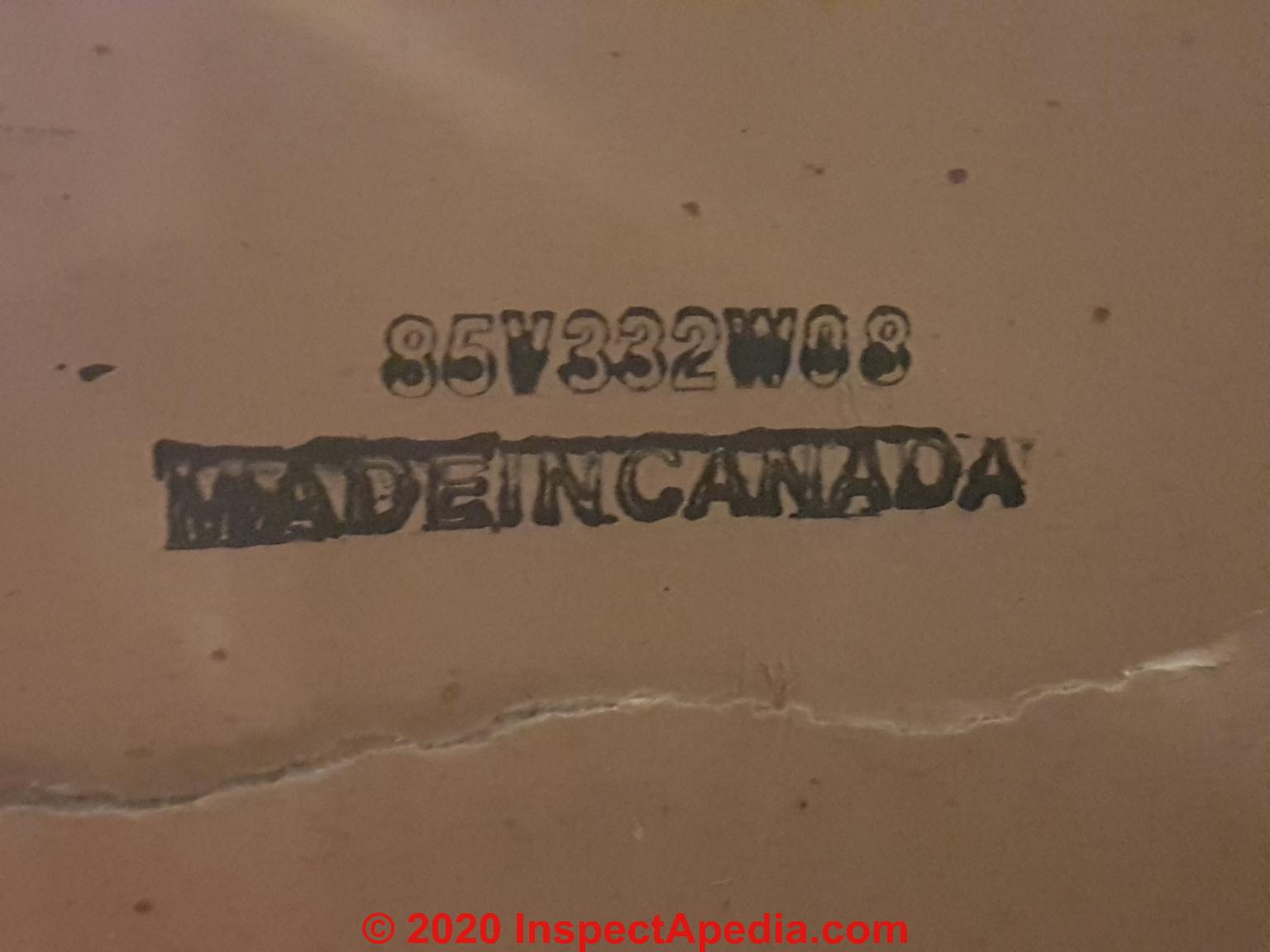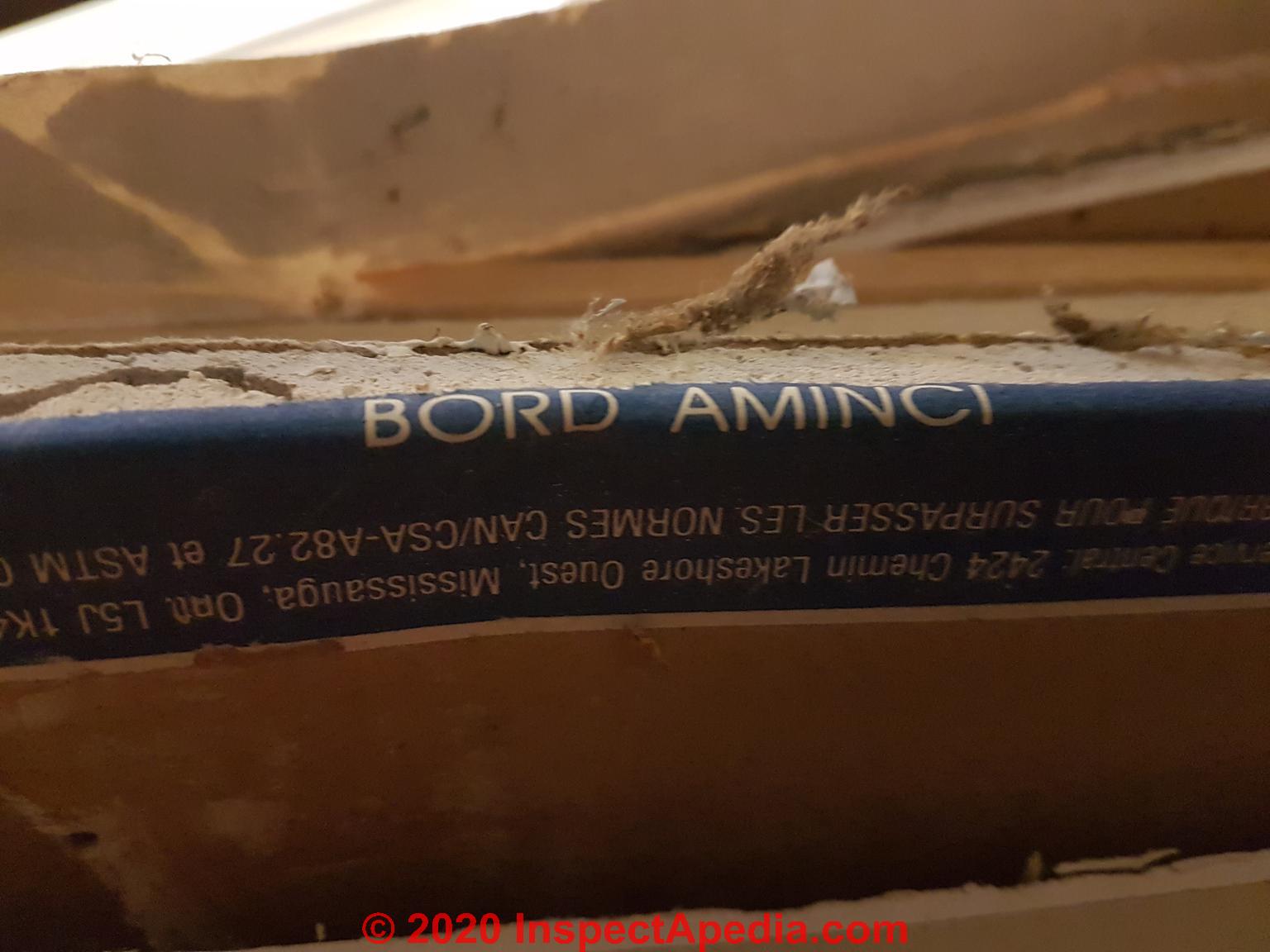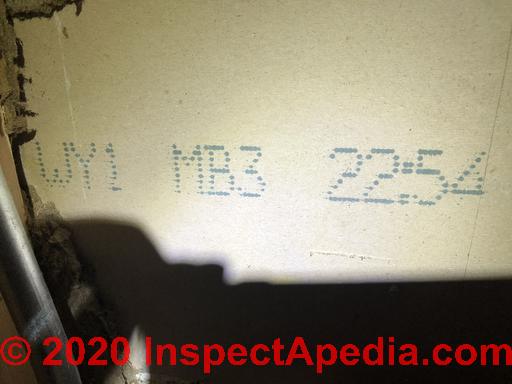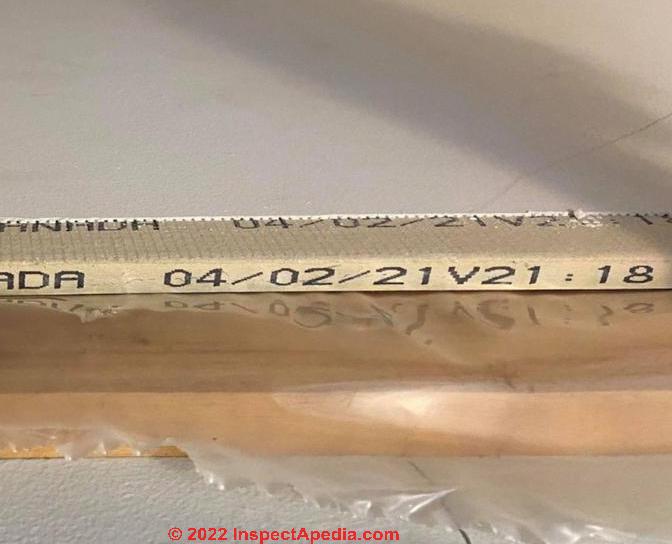 Drywall Type Identification Stamp Code FAQs
Drywall Type Identification Stamp Code FAQs
Q&A on Stamps, markings, numbers help ID drywall products including Type C, Type X, Fire rated
- POST a QUESTION or COMMENT about drywall, gypsum board, "sheetrock" panels, brands, manufacturers
Questions & answers on stamps and codes used to identify drywall or gypsum board manufacturer and productrion date.
This article series discusses the identification and history of both modern and older interior building surface materials such plaster and lath, Beaverboard, and Drywall - materials that were used to form the (usually) non-structural surface of building interior ceilings and walls. Our page top photo shows hand-split wooden lath backing for a plaster interior wall.
InspectAPedia tolerates no conflicts of interest. We have no relationship with advertisers, products, or services discussed at this website.
- Daniel Friedman, Publisher/Editor/Author - See WHO ARE WE?
Drywall Identification Stamps & Codes FAQs
These questions & answers about identifying various drywall or gypsum board products by stampsl found n the back surface were posted originally
at DRYWALL TYPE IDENTIFICATION STAMPS - be sure to review the drywall identification help given there.
Identify my drywall from these numbered stamps: 050276D17 & 0A08R72D
Hello, I recently had some water damage to my basement and am trying to identify some drywall the only stamp I can see says 050276D17.
Is there a way to know if this is an asbestos problem?
Republic Housing Corporation Drywall Identification in a 1963 Denver CO home
House was built in 1963. Here are some other photos of drywall from a different room. Any information about either piece would be greatly appreciated.
On 2023-06-27 by Worried co
by InspectApedia Publisher - Republic Gypsum Company drywall
@Worried co,
Those alpha-numeric stamps are probably production lot and date codes and don't identify the manufacturer, nor can we be certain of the date from just the codes, as how the codes are formulated are not entirely standard across manufacturers.
It would be invaluable if you could find another section of drywall end tape that shows the missing letters torn off preceding " ... of REPUBLIC HOUSING CORPORATION"
Key questions in answering your question "does this drywall contain asbestos" include:
Where is your building?
What sort is it? Is it manufactured housing?
What is the building age?
Also read ASBESTOS in DRYWALL inspectapedia.com/hazmat/Asbestos_in_Drywall.php
I think that The Republic Housing Corporation was a mobile home manufacturer, incorporated in Delaware but headquartered in Dallas Texas and who produced mobile homes up to 1974.
The Republic Housing Corporation was the parent company of Republic Gypsum, so I think that's the missing data from your drywall.
If that's the case and if the age of your building makes it likely that your structure was built before the 1980s then the drywall may indeed contain asbestos.
Bottom line:
Because the Republic Gypsum Company remained in business at least up to 2002, we need to know your building age.
For other readers - the company's trading name included American Gypsum.
REPUBLIC GYPSUM COMPANY LP (trading name, 2001-01-11 - 2002-01-23)
AMERICAN GYPSUM COMPANY (trading name, 2001-06-06 - )
by Worried co
Sorry, very stressful.
House was built in 1963. DENVER suburbs. First comment photo is drywall in a basement bathroom. Next two are from a basement bedroom. Single family residence.
Not sure about renovations but our neighbor said that the house was flipped prior the the last owner who purchased in 2003. Thank you
by InspectApedia Publisher - Home renovation history, building permits, and other details can confirm drywall age
@Worried co,
For a 1963 house the age of the drywall itself could be anywhere from early 1960s to recent, depending on the renovation history of the home.
When we remove existing drywall, IF there are no other older fastener holes or marks in the studs or joists to which the drywall was secured, I think that it's reasonable to guess that the drywall we removed was original.
You can easily spot older drywall nail or screw holes in wall studs or ceiling joists by noticing that as you remove drywall to expose wood framing you see nail or screw holes in the wood that do not match the fasteners in the present drywall that you're removing.
That can tell us that the present drywall is newer than the home.
Home renovation history, building permits, and other details can confirm that guess.
Treat the drywall and joint compound used on it as presumed to contain asbestos - or have samples tested.
Get some help for stress - most likely, the health hazard from stress over this far exceeds the health risk from the drywall.
Simply avoid making a dusty mess, or if you have to clean up drywall dust use damp wiping and HEPA vacuuming.
Identify this 1950's - 1960's drywall and tell me if it contains asbestos
I'm wondering if you can identify if this product would have be containing asbestos in it. The house was built in the 50-60's and remodeled in the 90's but I don't know if the drywall seen in this photo is original or changed.
I believe the stamp says Factory Mutual Research Corporation Audit Inspection Program and you can see GB-3 in the bottom corner, maybe denoting Gold Bond - 3 Drywall? - On 2023-03-29 by Al
by InspectApedia Publisher
@Al,
I'm sorry but we cannot tell the date of your drywall from that stamp.If it were manufactured in the nineties it would not contain asbestos.
A prudent step would be to presume that the drywall and joint. compound used at joints end covering screws or nails may contain asbestos.
The simple presence of those materials is not a measurable hazard in your home.
Only if you were planning demolition or disturbance of the material need you either treat it as containing asbestos or have representative samples tested.
For small jobs it's more prudent to treat the material as containing asbestos than to pay the cost of the asbestos test.
Let me know if you have further questions.
Here is another photo showing what I believe to be the date stamp. I'm assuming its manufacturered in the 90's but who knows
Decipher the date on this drywall in a home built in 1973: 09022N14
I came across this website and I just wanted to get more info on asbestos. I have this well that’s visible and I want to decipher the date on It.
On 2023-02-24 by 1973 home
by InspectApedia Editor
@1973 home,
Of course, from one message, we don't know much about your building construction or location, just its age.
That looks more like a production date code, not easily mapped to a specific vendor.
Unless there are additional markings you can find, what you can do is to pay attention to other contextual clues as discussed above on this page.
You can also review the asbestos drywall ID & advice at
ASBESTOS in DRYWALL
https://inspectapedia.com/hazmat/Asbestos_in_Drywall.php
Decode number on drywall in Branson, Missouri: 06042F18S
I asked a question about some ceiling tiles a few weeks ago, thanks for the response. Doing a remodel south of Branson MO, moved on to the drywall upstairs.
There is a number on the back but I’m not sure how to decipher. Best guess so far 42nd week of 2006. House was built in the late 70 s. Thanks in advance - Anonymous, Sep 19, 2022
On 2023-01-13 by Anonymous by private email
by InspectApedia Publisher - drywall date and production codes are not standardized
@Anonymous by private email,
What's indeed confusing is that while there's been a lot of talk about standardizing date and production codes, they're not.
If you thought the house was renovated around 2006 your guess would, still, be reasonable.
1963 Minnesota home with US Gypsum Company drywall
Our house in Minnesota was built in '63. The piece with the most words I could find said "... GYPSUM COMPANY" with red and blue stripes underneath.
The attached pic is the stamp I found on the back of the drywall, but couldn't find anything online to decipher. I sent in a piece of the drywall for an asbestos test and the result was negative.
On 2022-12-29 by Jakson
by InspectApedia Publisher -
@Jakson,
Perhaps US Gypsum Company.
See if you can find remnants of paper end tapes at the ends of drywall segments. Those often have additional imprinted data that can identify the brand.
Is there a database with drywall stamps?
Looking to identify this panel, was part of a supposed rated wall assembly, likely at least 35 years old, 3 5/8" steel studs.
This sheet (photo attached) against studs; and a 1/2" sheet we couldn't access stamps without additionally removing and entire sheet. Is there a database with these stamps? Anyone able to identify if this sheet (1/4") is part of a rated assembly? - On 2022-10-12 by Dzutski
by InspectApedia-911 (mod) - yes found here; 1/4" drwywall won't be fire-rated
@Dzutski,
Yes, the page above DRYWALL TYPE IDENTIFICATION STAMPS is a atabase of drywall identification stamps that can often tell us the manufacturer, production date, and different drywall classifications and ratings.You can see that your drywall which is only 1/4 in part of a wall or ceiling assembly but we can't see any more of the structure so can't comment on how the assembly might have been fire rated.
Certainly in modern construction, quarter inch thick drywall would not be likely to be considered a significant fire break.
Also see DRYWALL MANUFACTURER IDENTIFICATION STAMPS & DATE CODES
Identify drywall on a 2007 home in Cookeville TN - stamped "... since 1967"
Hello, trying to identify this drywall in a house we recently purchased in Cookeville, TN. House built in 2007. The only identifying marks I can find are: 850 2 100% recycled paper SINCE 1967
On 2022-10-09 by Chad A
by InspectApedia-911 (mod)
@Chad A,
CertainTeed Corp. partnered with French Compagnie Saint-Gobain in 1967 and was purchased by Saint Gobain in 1988.
That may be a clue.
Is there a allowable substitute for type x drywall that is acceptable code-wise for fire resistant subfloor/framing?
Is there a allowable substitute for type x drywall that is acceptable code-wise for fire resistant subfloor/framing between a living area and basement in a residential new build? Thank you On 2022-09-15 by Roar
by InspectApedia-911 (mod) -
@Roar,
I'm afraid I may not have a clear understanding of your question.
We wouldn't expect a layer of gypsum board to be part of the floor a subfloor layer in a building.
But I would expect drywall to be on the ceiling of the basement below.
In residential construction ordinary drywall will normally be what the building inspector would want on walks and ceilings.
I'm not sure why you're looking for fire rated drywall on a basement ceiling unless you're speaking about a mechanical room or Boiler Room where there are oil or gas fired Heating appliances.
What kind of drywall is identifyed by a R-4155 Wallboard Type VI stamp on a 1980's home
Hi - I found this within the chimney chase of my home built in the mid 1980s. I am wondering what type VI wall board is.? The type A chimney pipe is almost touching it.
On 2022-09-13 by Craig Kafura
by InspectApedia-911 (mod) - Type VI fire rated gypsum board
@Craig Kafura,
Type VI gypsum board meets U.S. Federal Standard SS-L-30D describing specific intended uses such as for interior walls and ceilings, plasterbase, fire resistant plasterboard intended to receive 1 or 2 coats of veneer plaster as its finished surface. That is also a fire-rated gypsum board, as we see in the text of the stamp itself as well.
Please tell us
- the location of your building: country and city
- the age of your building
- whether or not you have observed that the interior (room) side of the plaster board whose stamp you show is in fact coated with plaster.2022 guide to contemporary gypsum board types and identification codes
Readers:
For a more recent guide to gypsum board types and identification codes see
GYPSUM PANEL PRODUCTS TYPES, USES, SIZES, AND STANDARDS [PDF] (2022) US Gypsum Association, 6525 Belcrest Road, Ste 480 Hyattsville, MD 20782 USA, Tel: 301-277-8686 Web: www.gypsum.org - retrieved 2022/09/13, original source: https://www.gypsum.org/wp-content/uploads/2011/11/223-04.pdf
And for the older standard see
GYPSUM PANEL PRODUCTS TYPES, USES, SIZES, AND STANDARDS [PDF] (2017) USGA, Op. Cit., - retrieved 2022/09/13,original source https://www.americangypsum.com/sites/default/files/2022-01/ga-223_gypsum_panel_products_types_uses_sizes_and_standards.pdf
Members in 2017:
- American Gypsum Company LLC
- Certainteed Gypsum Canada, Inc.
- Certainteed Gypsum, Inc. Cgc Inc.
- Continental Building Products Operating Company LLC
- Georgia–Pacific Gypsum LLC
- National Gypsum Company
- Pabco® Gypsum
- United States Gypsum Company
How do I Decode drywall stamp 07226505112 ?
Hello i got this Number on back of my drywall anyone knows when it was manufactured - 07226505112 - Thank you On 2022-05-05 by Sly Bryjak
by Inspectapedia Com Moderator - how to decode older or non-conforming drywall stamps
@Sly Bryjak,
Near the top of DRYWALL TYPE IDENTIFICATION STAMPS please review our suggestions in the section titled
How to Decode Older or Non-Conforming Drywall Stamps
where we've added the following:
If using the 2017-and-later drywall date stamp decoder just above does not give sensible results then to proceed you will need to
Provide contextual information that helps check the reasonableness of any guess at the drywalls stamp by trying to decode the numbers and letters, provided by
DRYWALL STAMP DECODING by CONTEXTUAL CLUES
and where we use your drywall number 07226505112
as an example
Identify Drywall Stamped 0104432025
Hello, I'm trying to identify this drywall found in my home. It does not appear to have any letters on this code so I'm not quite sure how to identify it.
On 2021-12-13 by Michelle
by Inspectapedia Com Moderator - production date code doesn't readily identify the drywall manufacturer
@Michelle,
That's a common production date stamp but not a drywall manufacturer identification stamp.
Try looking for remains of edge tape on the drywall short ends, or for other manufacturer's stamps.Please tell us the country and city of location of your building and when it was constructed. Those clues can put bounds on the drywall's age and probable sources.
Decode Drywall production date code 032583602M4 and tell me if that means it contains asbestos
Nedd help identifying drywall code and if it contains asbestos.
On 2021-12-06 by Stephen schmidt
by (mod) - Decode Drywall production date code 032583602M4 doesn't identify the manufacturer
@Stephen schmidt,
That looks like a production date code, not easily mapped to a specific vendor.
You will want to review the asbestos drywall ID & advice at
ASBESTOS in DRYWALL https://inspectapedia.com/hazmat/Asbestos_in_Drywall.php
Do fibers I found in our drywall mean it is asbestos?
Was ripping out a bathroom and noticed the fibers in the sheet rock. Looked very similar to the new sheet rock we where putting in.
But as soon as I noticed the fibers I had masked up and took precaution if it is asbestos.
It’s walla board type-c fire resistant. Pix attached On 2021-11-09 by Stephen klch
by Inspectapedia Com Moderator - Example of a Type C Wallboard identification stamp
@Stephen klch,
Most likely you wouldn't be able to see asbestos fibers. Fiberglass fibers would be easier to see. Please take a look atSo if you actually see fibers I suspect you're seeing fiberglass.
Identify this drywall from the end tape text: Certainteed drywall edge tape date stamp
Can someone identify this board ? I believe this to be Certainteed gypsm board. Date stamped year 04 month 02 and date 21. Can someone confirm this to be correct? On 2021-11-06 by Karenkelly1989 -
by Inspectapedia Com Moderator - Drywall dated 04/02/21
@Karenkelly1989,
I see by the American Drywall Association stamp and a date stamp that's probably the production date.
With just that data I can not identify the manufacturer;
perhaps you can find some additional text all the drywall.
Decode drywall stamp F9M16N9 in a 1969 Iowa home
The only information on my drywall is this stamp " F9M16N9 ". The drywall is in a home built in 1969 in Iowa. The stamp is found on every 4' x 8' sheet that I have checked. Does this stamp tell who the manufacturer is, or the model of drywall, or a date of manufacture ? On 2021-10-08 by Andy
by inspectapedia.com.moderator - Drywall stamp F9M16N9
@Andy,
That's probably a manufacturer's production date stamp which usually will decode to identify a specific manufacturing plant as well. Those codes are not standard across the industry.
Unfortunately, with just the production date stamp and no other information, we can't make a useful guess about who the manufacturer was.
Sheetrock code number decoding: 12 10 7 W 10 M
Code number on sheetrock
12 10 7 W 10 M
Doesn't conform to the code as mentioned. Do you have any reference to manufacturing date
Thank you On 2021-08-26 by Phyllis -
by inspectapedia.com.moderator - Certainteed as example of drywall production date code stamp de-coding: 12 10 7 W 10 M
@Phyllis,
Without knowing the manufacturer we can only guess - since manufacturers may vary in how the use production date codes.
Look for another identifying stamp, or if the ends of drywall are visible anywhere, look at the paper end-tape to identify the product manufacturer and specific item.
But a typical drywall manufacturing date code format interpretation for your data would be as follows:
12 = Month: December
10 = Day: 10th
7 = year: 2007
W 10 M = plant code and production time, such as "Washington 10 AM Production Line "M"
Above is an example of one of these contemporary Drywall date code translations provided by Certainteed at www.certainteed.com/drywall/how-do-i-identify-board-i-am-using-how-can-i-tell-who-manufacturer-and-when-it-was-made/
Other manufacturers use similar but not necessarily identical production date and time stamp formats, as we describe at DRYWALL TYPE IDENTIFICATION STAMPS
Does "Fire Resistance Classification Wallboard" mean it contains asbestos?
Does this drywall contain asbestos?
On 2021-08-14 by Tyler
by inspectapedia.com.moderator (mod) - Undewriters Laboratories Inc. Fire-Rated Drywall Identification stamp
@Tyler,
It could contain asbestos, depending on the age of your drywall.Look for manufacturer's identification in other stamps on your drywall and let us know what you find.
Please see details at ASBESTOS in DRYWALL https://inspectapedia.com/hazmat/Asbestos_in_Drywall.php
Identify 970s drywall stamped #13163R x - is this fire-rated drywall?
I need to prove or add type x drywall on some common walls in my duplex. I found this marking. Does anyone know if that small "x" at the end is proof that this is type x? We have found other areas with more obvious type x. Likely from the 1970s. On 2021-07-17 by Kirsten
I am trying to ensure there is a firewall (fire rated drywall/type x) between my two units so I can reclassify my property as a duplex. We have had luck in finding most drywall on the shared wall is Fire Rated. However, there are a few sheets that have us stumped as we can only find patent numbers.
If we can prove these are fire rated, it would allow us to avoid demo-ing a whole wall in our kitchen. Does anyone know if there is a database or somewhere where I can find info on these patent numbers? I have had no luck on google. It is 5/8" drywall. Any help appreciated. Thanks!
by (mod)
@Kirsten,
I agree it's possible that that little "X" might indicate fire rated drywall on a 1970s gypsum board, but the rest of the numbers look like a production run not a manufacturer identification stamp. I wouldn't rely on that X , I would look for other stampings identifying the manufacturer and standards that applied.
Also see if you can find the printed end tape on the drywall ends if they're exposed anywhere in your duplex.
by Kirsten - intumescent paint permits avoiding kitchen cabinet tear-out
@inspectapedia.com.moderator, Thank you for the response! Bummer the patent couldn't be tied to a fire rating. The drywall you see is the back of my kitchen with a whole row of kitchen cabinets behind them. So to replace that drywall, I would need to tear out the kitchen cabinets.
However, I had some success with my building department who is going to allow me to use intumescent paint in that wall cavity and not make me replace with type X. So paint in the cavity and then type x on top to reclose the wall (if that makes sense). Woohoo! Thanks for the help. This site has been a great resource for me through this project!
by inspectapedia.com.moderator
@Kirsten,
Thank you for the follow-up as I will help other readers. If I understand the question correctly you are working on the cavity side of the drywall that we are discussing.In that case one must ask if the building department would have accepted you installing fire rated gypsum board either in the cavity against the existing drywall or on the other , exposed side of the same wall.
by inspectapedia.com.moderator (mod) - patent number research sometimes can identify asbestos-containing materials or fire-rated drywall and can ID its age
@Kirsten,
A quick patent search finds
- Johnson, Gordon C., and Samuel Sterman. "Process for sizing paper with epoxy silicone and resulting products." U.S. Patent 3,431,143, issued March 4, 1969.
- David, Bieri, and Edward S. Coia. "Gypsum wallboard and method for producing same." U.S. Patent 3,389,042, issued June 18, 1968.
Neither of these patents address fire resistance nor even use the word "fire" in the patent disclosure. They do give a floor to the possible age of your drywall. It would not have been made before the dates of patents whose number are stamped on the product.
Perhaps if you say more about why you'd have to demolish an entire kitchen wall we can offer more advice. That sounds, frankly, a bit extreme.
Seems more-likely you could, at worst, add a layer of fire-rated drywall somewhere on the wall structure.
How to find out where my drywall was manufactured?
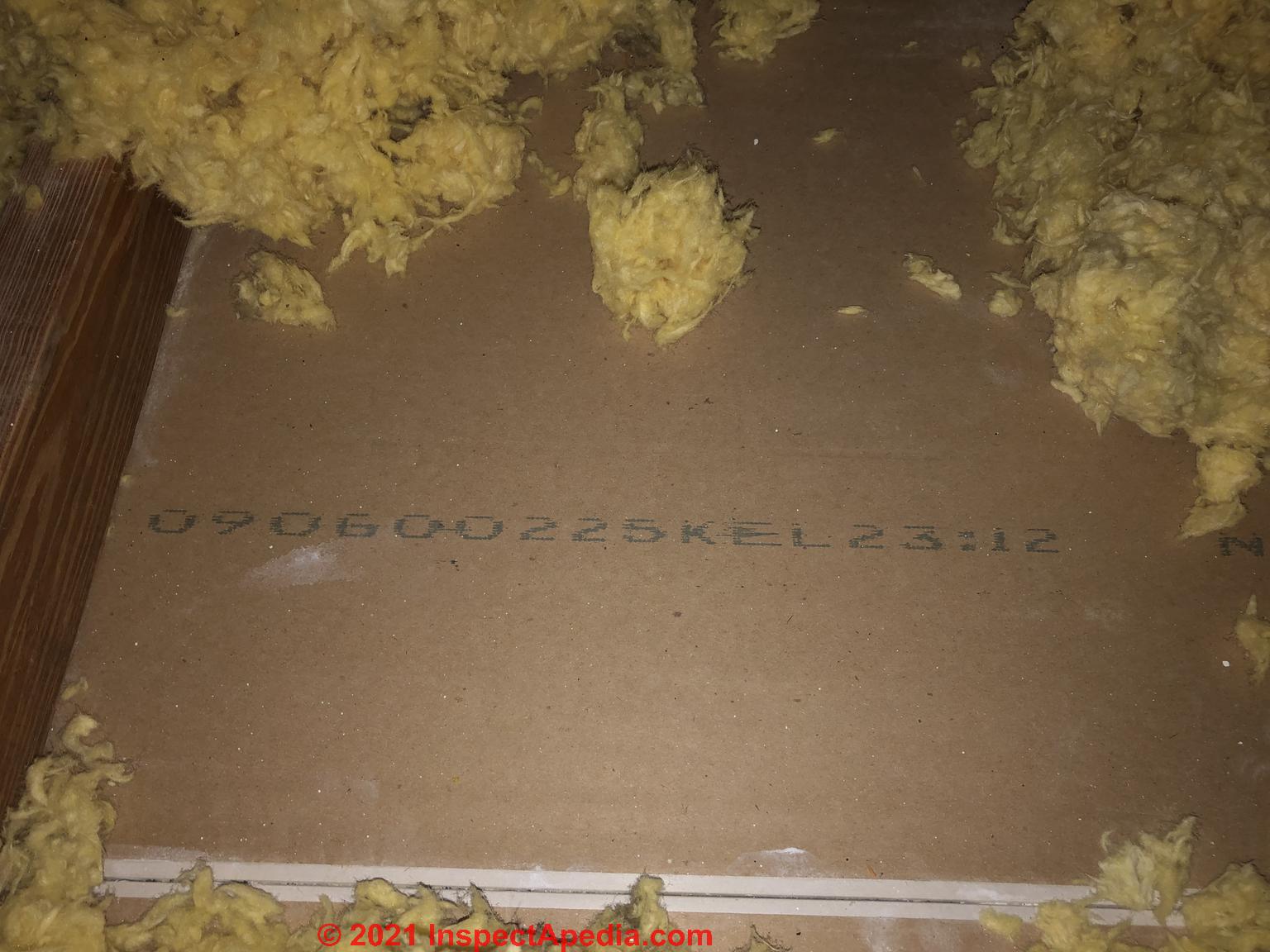
Can anyone help identify where this drywall was manufactured? On 2021-07-08
by Matt
by (mod) - decode this alphanumeric drywall stamp: 090600225KEL23:12
@Matt,
Translating identification stamps on drywall is made a bit tricky in part because depending on the age of the product its ID stampings may comply with different standards. You'll see that in the variation in the drywalls ID stamps given in the article above.
According to the U.S. Gypsum Association, in 2011, Specification C1264 for drywall was modified to require each individual sheet of gypsum board manufactured to comply with Specification C1396 to have the following information legibly printed on the back surface of each board, parallel to the bound edge of the board:
- The name of the manufacturing company
OR
- a unique alpha code identifying the name of the manufacturing company.
The decision to print the name of the company or to create and use a unique code is at the discretion of the company.
The standard also requires:
- A code identifying the manufacturing facility and, where applicable in a multi‐line facility, the production line. (that's why your code contains 3 alphabetic characters)
- A code identifying the date and time of manufacture.
- The country of manufacture as designated by the three letter code in ISO 3166‐1
So looking at your drywall, in general tge date code contains the identification of the plant at which the drywall was manufactured, (not an actual text string naming the manufaccturer) - so to be sure we have the code translated exactly correctly we usually have to get to the manufacturer itself.
In your photo I think I see the following date code:
090600225KEL23:12
September 06, 00 [probably 2000]
0225 - uncertain - possibly production line machine ID
KEL - Manufacturer ID and plant ID
23:12 the hour of production
Look for the Paper End Tape on Your Drywall
If you can pull back insulation at a location to show the end or edge tape on the drywall often you will find the product manufacturer's name printed there.
The end tapes on most manufacturers contain the following information, using and excerpting from drywall ID information from CertainTeed drywall as an example:
- Name of manufacturer
- Brand or product name
- Overall dimensions [thickness and length] as well as a set of lettings describing the edge detail. Most gypsum board is tapered edge, or TE.
- End tapes are also color coded per product, so they can be readily identified from a distance or when in storage.
Many drywall products that use a tapered edge (to provide space for taping and finishing edge butt joints) also imprint there similar manufacturer information, but once the drywall is installed and taped you won't be able to see that data.
Many drywall products also include the UL label or stamp information giving the UL listing or standard with which the drywall complies. This can identify fire-rated drywall, for example.
Some specialty drywall products such as tile backer boards do not use paper end-tapes but instead print the product identification in an inked band across the drywall surface.
Can the stamps on this Canadian drywall tell me if it contains asbestos?
Hi, I’m currently starting a Reno on my home and have come across some gyproc that I don’t want to mess with until I have a better idea of whether or not it might contain asbestos.
Any insight is appreciated. House was built in 1975 in Victoria bc Canada, and had some sort of Reno in 1996.
On 2021-04-08 by Jeff
here is another pic
- by (mod) -
@Jeff,
Here is what we know about ASBESTOS in CANADIAN DRYWALL https://inspectapedia.com/hazmat/Asbestos-in-Canadian-Drywall.php
In a 1975 house, unless you know this drywall is from the 1996 renovation, you'd treat it as presumed to contain asbestos - or if that means facing a big cost, have samples of the drywall AND of joint compound tested for asbestos
You can find ASBESTOS TEST LABS in the ARTICLE INDEXby Jeff
thank you for taking the time to post your opinion on my question. I will send a few samples off before proceeding
- by (mod) -
@Jeff, thanks; do let us know the test result as that will help other BC and other Canadian readers.
Does this 5/8" thick Wallboard stamp Issue No. B-4007 Type VI mean it contains asbestos?
On 2021-03-29 by Chris bridges
- by (mod) -
@Chris bridges, the chances that your fire-rated drywall contain asbestos are good if it was made in North America before ca 1986
Identify drywall in BC, Canada, stamp # 8612160631B
I am trying to indentify if some drywall we have from a house we bought in BC Canada has asbestos. There is a stamp on the back but no other id marks on the back or sides. I have attached a photo. The number as I read it is 8612160631B Any assistance is appreciated. Thank you. - On 2021-02-22 by Den Clark
by (mod) -
@Den Clark, I can't identify the manufacturer of your drywall although it's certainly likely to be a Canadian one. From the number I suspect that it was manufactured in 1986. Is that consistent with the age of the building where it's installed?by Den Clark
Yes, the house was built around that time.
I appreciate you taking the time to answer. Thank you.by (mod) -
@Den Clark,
Also see Canadian DOMTAR Drywall
https://inspectapedia.com/interiors/Drywall-Manufacturer-Identification-Stamps.php#Domtar
Tell me the dates of production of this particular gypsum board saying Manufactured to meet ASTM C36 and CSA A82.27-M etc.
Can someone tell me the dates of production of this particular gypsum board?
Would anyone know if gypsum board is required to be date stamped on the back? Thank you very much. - On 2021-02-10 by Jennifer S -
Reply by (mod) - Noting standards-compliance stamps on drywall might help bracket the drywall-age and purpose
Jennifer:
Here's a clever detail: C36/C36M-03e1 Standard Specification for Gypsum Wallboard was withdrawn in 2005, so while we don't know when your particular piece of drywall (gypsum board) was manufactured, it's reasonable to GUESS that it was in or prior to 2005. [OR that the manufacturer has not updated their product labeling. ] Source: ASTM, https://www.astm.org/Standards/C36.htm
ASTM C1396 / C1396M - 17 Standard Specification for Gypsum Board remains active.
The other standards cited CSA A82.27 was published in 1991 and has also been withdrawn.
CAN/CSA-A82.27-M91
Gypsum Board Covers requirements for gypsum board designed for use with or without the addition of plaster, for walls and ceilings.
Status: Withdrawn - source: https://www.scc.ca/en/standardsdb/standards/4876
NYC BSA#682-56-SM a New York City drywall standard is, unfortunately far more difficult to research thanks to the similarity to BSA - Boy Scouts of Americaby Jennifer - home buyer claims cover up is "proven" by drywall date stamp
I can’t even begin to thank you enough for your reply. Our homebuyer of 2.5 years ago is suing us saying we hid structural issues beneath this gypsum board which they state was manufactured in 2008.
We never installed any gypsum board and have been intimidated that this buyer (an attorney himself) is claiming that since we lived in the house in 2008 that this (based on the UPC code) gypsum wallboard was purchased and installed that year. This is simply a lie.
I didn’t know how to research anything of this nature which is foreign to me. We hid nothing but were confused that he said he found this tag on the back of the gypsum board and it proved we installed it in 2008 which we didn’t do at all.
We feel he is just trying to get us to pay for an expensive remodel (and the house is historic being built in 1844)
All we ever did was apply two coats of paint during the years we lived in the house on the walls.
One last question - based on the CSA number are you saying that the gypsum board was last withdrawn in 1991?
by (mod) - how does a building standard "withdrawn" date help identify drywall age? Forensics of drywall age and history determination in a home.
Jennifer:
I'm not saying that gypsum board itself was last withdrawn in 1991. I'm saying this:
If a building standard was withdrawn in 1991, and if drywall bears a stamp saying that the product complies with a now-withdrawn standard, the MOST LIKELY (but not absolutely certainly) the drywall was manufactured before that withdrawal date.
My reasoning is that a manufacturer is more-likely to stamp their drywall with references to standards that are active at the time the drywall was manufactured.
The reason I emphasized "most likely" is because I am not aware of anyone who is policing the timeliness of or use of drywall stamps by manufacturers. To get further on this question you'd need to contact the specific manufacturer of your specific drywall and find someone who knows how that producer uses and applies product stamps, and then get them to clarify exactly when they stop using or update the text in the stamps they put on their products.
An alternative, more-forensic approach to answering the assertion by someone that drywall in your building has been removed and replaced might be possible by observing variations in drywall fasteners and in nail or screw hole patterns in wall studs that might be exposed when the current drywall is removed.
For example, , during its long life, the wall coverings in your home were changed just once from plaster to drywall, then when we remove the current (and old) drywall we might see on the faces of the studs the marks where plaster and lath were removed, and we might see a single set of matching screw or nail holes that fit exactly the drywall that has just been removed.
Of course nothing would prevent there having been multiple generations of drywall installed, removed, installed-new in a home that is more than 150 years old!
by Jennifer S - gypsum board dating, what the standards are for date stamping and manufacturer on the back ?
Regarding gypsum board dating, can the moderator comment on what the standards are for date stamping and manufacturer on the back of it. A home buyer of ours from years ago is suing us for fraud saying we put up drywall to hide defects stating that “based on the UPC code” it was purchased in 2008 or later when we resided in the house.
The home buyer is a less than scrupulous attorney who seems to be pulling out whatever stops he can for us to pay for his expensive renovation of a home dating back to 1844 - bee hive ovens and all.We lived in the house for 16 years and the only thing we ever did to the drywall that existed on those walls when we purchased the houses was update colors twice.
Can the moderator or anyone else who has knowledge kindly weigh in on how drywall can be legitimately dated and is it standard in the industry (and for how long) that dry wall be date stamped in the United States? We are truly at a loss.
While we realize that we did not install this board, when this buyer intimidates us through UPC codes stating it was manufactured in 2008 or later it makes no sense.We didn’t install drywall. Can anyone kindly weigh in on this? In my research I learned that certain markings started in 2011 and 2012 due to a drywall act, but was it standard in the industry that drywall as far as thirty years back could have a date stamp/manufacturer on the back? So many thanks
by (mod) - history of use of UPC and Standards Stamps on Drywall vs Drywall Age
Jennifer
Thank you for the important and troubling question. I've done some additional research on the relationship of drywall identification stamps, standards, and UPC codes and their role in dating or setting thte age of specific drywall or gypsum board products.The earliest drywall identification stamp I've seen was from 1894.
Dates of Drywall Standards: You'll see in recent comments on this page, that we can sometimes make a reasonable guess at the age range for a drywall product by noting the dates at which standards cited in a drywall stamp or imprint were first published or last withdrawn.
Patent research: And sometimes we use patent research to get a similar "oldest" or "newest" plausible age.The use of UPC: Universal Product Codes found on drywall can set a "no older than" date in the U.S. as the mid 1970s. It might be possible to trace a specific UPC to a specific production lien of drywall made by a particular manufacturer, though often those UPCs are likely to appear on a product over quite a few years.
Those tools are reasonable in that no one could successfully argue that somebody put up drywall in 1954 that bears a standard ID or number that was first published in 1985.
But all of those analyses are accurate only to a range of dates, not to a precise date.
Corroborating Evidence of Drywall ID & Age: For that reason I typically advise readers who have some reason to care for a more-accurate date of any building material to review
- the original date of building construction
- dates of and records of building modifications
- the plethora of surrounding building age clues that we give starting at AGE of a BUILDING, HOW to DETERMINE - home
Pending further research on the use of drywall stamps, I note that my OPINION, having looked at this topic for some years now, is that there is not consistent use of drywall stamps and identification markings; there is wide variation in when product information is applied and also how it is applied: ink stamps, paper labels, tear-off strips on the bottom edges of drywall, etc.
It varies considerably by manufacturer.
But I can assure you that while we may find gypsum board or drywall that bears no identification mark, for at least some manufacturers, product identification stamps have appeared on the back side of lots of drywall in the U.S. since 1912 or earlier.
Those stamps, as you'll see at DRYWALL TYPE IDENTIFICATION STAMPS these stamps or imprints on the hidden or wall cavity side of drywall appear in a wide range of formats, colors, and vary considerably in what information is provided. Some, not all, include reference to fire or other classifications.What is the actual issue here? Can we get that clarified? If so we might conclude that the age of the drywall is completely irrelevant or there may be other more-direct methods of answer the question of who did what when to the building.
Also see the historical data on drywall composition and uses at
DRYWALL & GYPSUM BOARD types, age, history.
The first use of UPCs or Universal Product Codes in the U.S. was in 1974. Source: "The History of Barcodes" - https://www.barcoding.com/ where we read that barcode readers have been in use in the U.S. since 1952, and that UPCs came into first use 22 years later.
What I take from this is that if drywall in your home bears a UPC, from that information alone, that is without tracking down the specific drywall manufacturer's use of a specific UPC Number, the drywall could be as old as the 1970s.
Finally: from what you've told me, and without any onsite data, I'm tempted to reply to the current owner's attorney: "You're just fishing, and ... there's no fish in this water."by Jennifer - Our homebuyer of 2.5 years ago is suing us saying we hid structural issues beneath this gypsum board
I can’t even begin to thank you enough for your reply. Our homebuyer of 2.5 years ago is suing us saying we hid structural issues beneath this gypsum board which they state was manufactured in 2008.
We never installed any gypsum board and have been intimidated that this buyer (an attorney himself) is claiming that since we lived in the house in 2008 that this (based on the UPC code) gypsum wallboard was purchased and installed that year.
This is simply a lie. I didn’t know how to research anything of this nature which is foreign to me. We hid nothing but were confused that he said he found this tag on the back of the gypsum board and it proved we installed it in 2008 which we didn’t do at all
. We feel he is just trying to get us to pay for an expensive remodel (and the house is historic being built in 1844) All we ever did was apply two coats of paint during the years we lived in the house on the walls. One last question - based on the CSA number are you saying that the gypsum board was last withdrawn in 1991?
...
I can’t even begin to thank you for all the research you performed on my behalf. It provided help beyond measure. I did discover the owner of the UPC code is Lafarge Corporation who sold their gypsum board business to Continental Building Products. It was then sold to CertainTeed.
I am trying to get information from them now. Thank you again @danjoefriedman. Every bit of info and detail and resource your referenced made this painful, stressful task where I was completely at a loss and had no understanding of until no so easy.
by (mod) - owner of the UPC code is Lafarge Corporation who sold their gypsum board business to Continental Building Products. It was then sold to CertainTeed.
Thank you for the follow-up, Jennier; I'm glad to offer what assistance we can, without bias as that makes it more-useful;
working together makes us smarter.
If you have dates or references for the Lafarge sale to Continental Building Products and for the subsequent sale to CertainTeed those would be helpful to add here (this page)
or at DRYWALL & GYPSUM BOARD COMPOSITION & HISTORY - composition & History
Does UL Stamped Classified Wallboard R-3501, 5/8" Fire Resistance Classification Type FSW-3 mean that it contains Asbestos?
Just wondering if this contained asbestos.
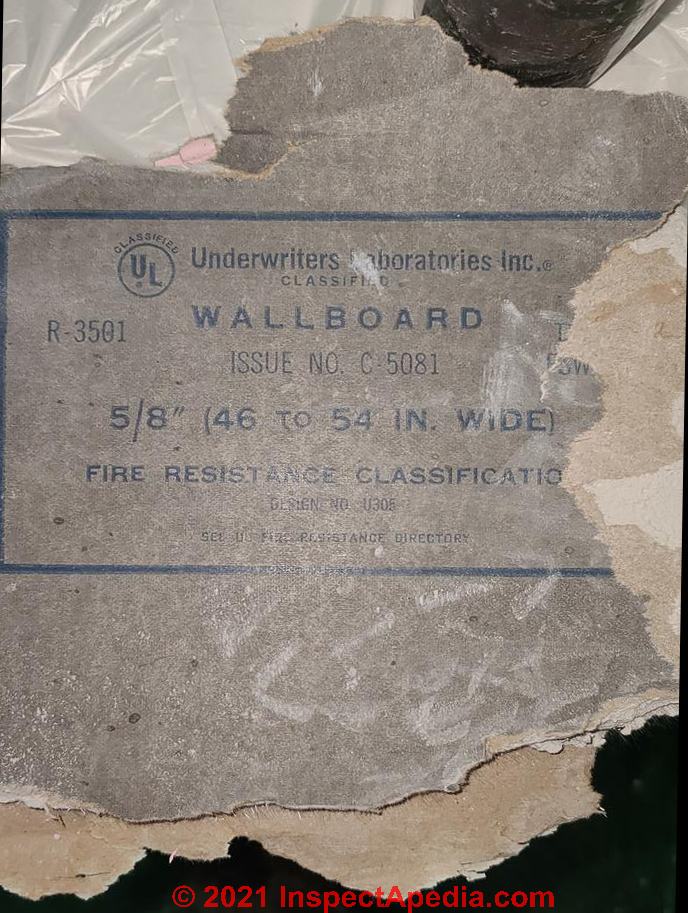
On 2021-02-09 by Ben
by (mod)
Ben
When you see fire resistant gypsum board or wallboard from before 1980s you must consider that it may contain asbestos as might the drywall compound used on the board joints.To know for certain you would need to have representative samples tested.
Does WINROC drywall with Bar code 726770133 contain asbestos?
We are doing renovations on our 94-95 built cabin..so the drywall should be around this period.
It is from WINROC and a has that company name on edges and barcodes like 726770133 and on side too is a stamp like attached.
So hope I am asbestos free and can take to dump and show this info? comments?
here is a picture of the stamp on side [above]
On 2020-08-07 by rob
by (mod) -1990s Canadian WINROC drywall identification by end stamping
Rob:
By 1990 most manufacturers were not using asbestos in drywall.
Any other stamps or markings? Patent nos. ?
United States Gypsum Company, Chicago, "New Improved SHEETROCK, The Fireproof Wallboard" may date from the early 1920s
Hello and thank you for the informative site!
I'm looking to find any information about the Sheetrock that appears to be part of the original design and build of my house. The house was built with all recycled lumber and, at this time, the Sheetrock is the only material I can identify that might be able to date when it was actually built. Other indicators have only narrowed it down to between 1907 and 1932!
It is 1/4 inch USG Sheetrock with a light orangish color label running the length of the panels.
The latest patent date listed on the label is for a 1921 patent. There are no other labels visible and no date stamps to be seen. Any information on dating this product would be greatly appreciated.
I have a house in California that was constructed out of used lumber with its interior finished in 1/4 inch Sheetrock.
I'm interested in figuring out about when the house was built. The Sheetrock appears to be original to the house's design plan. Any help with dating the Sheetrock would be much appreciated.
It has an orange colored label running lengthways on the panels with the latest patent number being for a1920 patent. There are no other labels visible anywhere and no date stamp to be found.
The patent numbers are 1029328, 1034746, 1330413, 1358508, and 1383249.
The house is in a fairly remote mountain area of Placer County, California.
The county assessor dates my house at 1932 but it and the parcel weren't taxed separately from the parcel it was subdivided from in 1931until 1964. The house was built out of a deconstructed 1897 hotel.
Newspaper mentions document that the hotel was taken apart in 1907 so I know the house was built after 1907. Photos of the construction groundbreaking show the original owner/builders in clothing characteristic of the 1920's and a later photo shows the house with very mature vegetation and a vehicle with 1938 registration.
The house was built by a longtime company superintendent and the land that was deeded to him and his wife was part of the greater property and business he managed for them. In the industry it was typical for employees to live on the company property and I suspect the house was built before he was deeded the property.
It's difficult to know if later patents would be attributed to that product and USG doesn't have a historian or archivist to help with dating it. Sorry to be vague about the location and company's industry, it is somewhat unique so, for security purposes, I don't want to publish that. Thank you - On 2020-07-23 by S. T.
by (mod) - US Gypsum Sheetrock - "fireproof wallboard" identification - 1920s vintage per patent research
S.T.
Thank you for the photo and question about US Gypsum Sheetrock - "fireproof wallboard". I'll see what else I can find and would like to know what other indicators you've used to narrow the age to between 1907 and 1932.
You used one of my favorite tricks to look into the age of this material: patent number research. The 1921 patent means that the oldest this sheetrock could be is 1921.
Tell me the location: country, city, and what you can about the building where it's installed.
Please also tell me all of the patent numbers, as the photo is a bit blurry even at full size.
Can I Use drywall stamps to establish when my house was built
Hi, I found this drywall while renovating my house. I really need to establish the construction date of my house and I don't know what to think of all these years. Should I consider the last date, or could it be older than the last date? Many thanks!
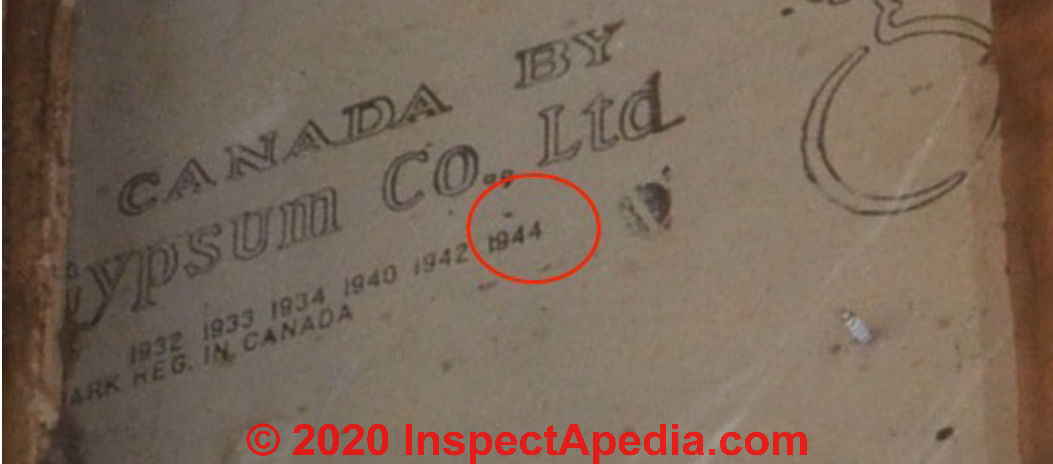
On 2020-05-08 by Annie
- by (mod) - patent numbers can put bounds on possible age of the drywall and thus the home
Those are probably patent number dates, Annie, setting a floor under the age of that material.
Sure, the home could be older than those dates.
What kind of drywall is "TYPE GPFS-3" and "ISSUE NO. B-2721"
wallboard is stamped "TYPE GPFS-3" and "ISSUE NO. B-2721". I need to figure out what kind of drywall this is. On 2020-03-12 by Anonymous
by (mod) - GPFS-3 Georgia Pacific drywall IDentification
Anon
GPFS-3 may be a Georgia Pacific drywall product, and FS could be fire-resistant - I tried searching the GP site without success but you might give them a request message at https://www.buildgp.com/contact-us/
Certain-Teed Bestwall / Beaver Gypsum Fireproof Drywall History & Asbestos content
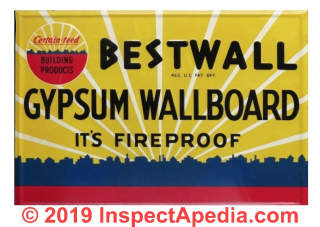 Recently began to take down some old gypsum and I noticed that it said "Certain-Teed Beaver Gypsum Fireproof. Does anyone know anything about this? On 2020-01-17 0 by Nick
Recently began to take down some old gypsum and I noticed that it said "Certain-Teed Beaver Gypsum Fireproof. Does anyone know anything about this? On 2020-01-17 0 by Nick
by (mod) -
Thanks for the images, Nick/Oswana21
In addition to adding them to the DRYWALL TYPE IDENTIFICATION STAMPS page I'll include what you've provided at
BESTWALL DRYWALL ASBESTOS
where I've made a separate page for Bestwall and its history.
Your photos show by edge view what looks like a paper covered gypsum board so it's not likely that your wallboard is the earliest (sawdust and gypsum-based) version of BestWall - as we guessed, perhaps from the 1950s or even later.
If you are able to find a stamping specifically saying "Bestwall" that would be helpful.
I can't make out all of the text in your images; if you can translate it do let me know what it says - as much as you can.
Patent numbers are also helpful for research.
I did see the words New York on one of your stamps.
Bottom line: treat the drywall as presumed to contain asbestos or have a sample tested.
Your gypsum board may be quite old - dating probably from the 1930s to 1950s. Certainteed purchased Beaver Products in 1928.
Certainteed's Bestwall Gypsum board contained asbestos through 1976 or possibly 1977 depending on when the product installed in that year may actually have been manufactured. You should also consider that joint
Asbestos in drywall in 97 yr old house in Vancouver, BC, Canada stamped "85V332W08 MADE IN CANADA"
Hey all, Enjoyed looking through the pics to see if my boards are similar, but no!
Trying to determine if this can safely go in a landfill or needs asbestos/hazardous waste protocol...? Pulling down various drywall bits from renos over the past 10~30ish years in a 97 yr old house in Vancouver, BC, Canada.
Above: Text: 85V332W08 MADE IN CANADA
Drywall end tape text: BORD AMINCI ... 2424 Chemin Lakehorse Quest., Mississauga, Ont. L5J 1K... ... POUR SUPRASSER LES NORMES CANSA-A82.27 et ASTM ...
Below: Another pic of a diff type of drywall board... same reno. Thanks. Text: BORD AMINCI ... 2424 Chemin Lakehorse Quest., Mississauga, Ont. L5J 1K... ... POUR SUPRASSER LES NORMES CANSA-A82.27 et ASTM ...
On 2020-01-15 by quetzo_van -
by (mod) - Asbestos in this Canadian Drywall? Type C fire rated drywall (Improved Type X)
I can't say for sure if that gypsum board contains asbestos, but indeed some detail about the CAN/CSA standard A82.27 addresses fire-rated gypsum board, SOME of which products, depending on when they were made and by whom, could contain asbestos.
I think that's a Type C gypsum board.Type C fire rated drywall (sometimes referred to as Improved Type X) is similar in composition to Type X, except that it has more glass fiber reinforcement and other ingredients in the gypsum core that makes its fire resistive properties superior to Type X.
Type C gypsum board is available in 1/2-inch (12.7 mm) and 5/8-inch (15.9mm) thicknesses. - source FIRE RATED GYPSUM, Certainteed https://www.certainteed.com/drywall/what-fire-rated-gypsum/
It would be helpful to know the age of the product or at the very least the age of the building where it was installed and a guess at when it was installed.
CAN/CSA-A82.27-M91
Gypsum Board
Covers requirements for gypsum board designed for use with or without the
addition of plaster, for walls and ceilings.
Status: Withdrawn
SDO: CSA
Language: English
Publish date: 1991-06-30
Supersedes: A82.27-M1977
Keywords: BOARDS, COMPOSITION, CONSTRUCTION MATERIALS, GYPSUM, PHYSICAL TESTING,PLASTERBOARD, STRENGTH OF MATERIALS, SURFACE TREATMENT, WALLBOARD
ICS Codes: 91.100.10;
Standard Number: CAN/CSA-A82.27-M91See details at CANADIAN DRYWALL ASBESTOS
AND
What is the fire rating for this old drywall marked WY1 MB3 22:54 ?
Trying to identify the fire rating for this dry wall these are the only makings I could find.
On 2020-01-14 by Mark Fricke
Reader Follow-up re the drywall above: no asbestos - Vancouver BC
In response to the (mod) who took a look at the pics of my board with no fire-rating stamps of any kind on it - the house is located in Vancouver, BC, Canada, and the install happened likely before 1986 (so 34 years old now). The home is 97 years old, built 1923.
by (mod) - If you don't see a UL classification, a Type X or Type C or U495 and V416 stamp,
I don't think those characters identify the manufacturer explicitly but probably do identify a production plant and perhaps encoded date and time.
If you don't see a UL classification, a Type X or Type C or U495 and V416 stamp,
Then I would assume that the drywall is not fire rated or that it was made before those US stamps and datings were used.
It would be helpful to know the country and city where the drywall is located and the age of it or at least the age of the building.
...
...
Continue reading at DRYWALL TYPE IDENTIFICATION STAMPS - topic home, or select a topic from the closely-related articles below, or see the complete ARTICLE INDEX.
Or see these
Recommended Articles
- ASBESTOS in DRYWALL
- DRYWALL, FIBERBOARD, PLASTER INTERIORS - home
- DRYWALL & GYPSUM BOARD COMPOSITION & HISTORY - composition of drywall & drywall history
- DRYWALL MANUFACTURER IDENTIFICATION STAMPS & DATE CODES
- DRYWALL TYPE IDENTIFICATION STAMPS
- GYPSUM BOARD GYP ROCK SHEATHING
- GYPSUM BOARD PLASTER LATH SYSTEMS
- PLASTER TYPES & METHODS in BUILDINGS
Suggested citation for this web page
DRYWALL TYPE IDENTIFICATION STAMP ID FAQs at InspectApedia.com - online encyclopedia of building & environmental inspection, testing, diagnosis, repair, & problem prevention advice.
Or see this
INDEX to RELATED ARTICLES: ARTICLE INDEX to BUILDING INTERIORS
Or use the SEARCH BOX found below to Ask a Question or Search InspectApedia
Ask a Question or Search InspectApedia
Questions & answers or comments about ages & types of wall & ceiling materials, installations & practices.
Try the search box just below, or if you prefer, post a question or comment in the Comments box below and we will respond promptly.
Search the InspectApedia website
Note: appearance of your Comment below may be delayed: if your comment contains an image, photograph, web link, or text that looks to the software as if it might be a web link, your posting will appear after it has been approved by a moderator. Apologies for the delay.
Only one image can be added per comment but you can post as many comments, and therefore images, as you like.
You will not receive a notification when a response to your question has been posted.
Please bookmark this page to make it easy for you to check back for our response.
IF above you see "Comment Form is loading comments..." then COMMENT BOX - countable.ca / bawkbox.com IS NOT WORKING.
In any case you are welcome to send an email directly to us at InspectApedia.com at editor@inspectApedia.com
We'll reply to you directly. Please help us help you by noting, in your email, the URL of the InspectApedia page where you wanted to comment.
Citations & References
In addition to any citations in the article above, a full list is available on request.
- In addition to citations & references found in this article, see the research citations given at the end of the related articles found at our suggested
CONTINUE READING or RECOMMENDED ARTICLES.
- Carson, Dunlop & Associates Ltd., 120 Carlton Street Suite 407, Toronto ON M5A 4K2. Tel: (416) 964-9415 1-800-268-7070 Email: info@carsondunlop.com. Alan Carson is a past president of ASHI, the American Society of Home Inspectors.
Thanks to Alan Carson and Bob Dunlop, for permission for InspectAPedia to use text excerpts from The HOME REFERENCE BOOK - the Encyclopedia of Homes and to use illustrations from The ILLUSTRATED HOME .
Carson Dunlop Associates provides extensive home inspection education and report writing material. In gratitude we provide links to tsome Carson Dunlop Associates products and services.


